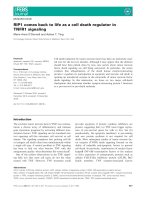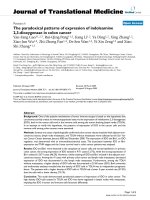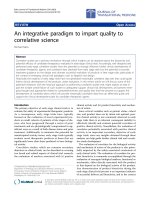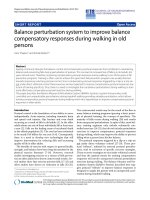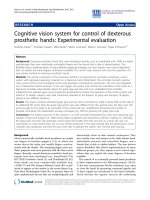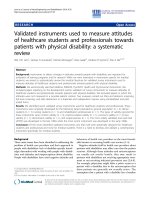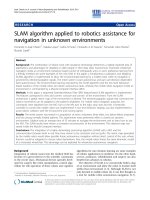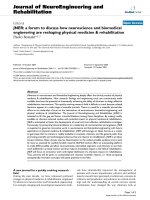Báo cáo hóa học: " Balance perturbation system to improve balance compensatory responses during walking in old persons" docx
Bạn đang xem bản rút gọn của tài liệu. Xem và tải ngay bản đầy đủ của tài liệu tại đây (762.96 KB, 6 trang )
JNER
JOURNAL OF NEUROENGINEERING
AND REHABILITATION
Shapiro and Melzer Journal of NeuroEngineering and Rehabilitation 2010, 7:32
/>Open Access
SHORT REPORT
© 2010 Shapiro and Melzer; licensee BioMed Central Ltd. This is an Open Access article distributed under the terms of the Creative Com-
mons Attribution License ( which permits unrestricted use, distribution, and reproduc-
tion in any medium, provided the original work is properly cited.
Short report
Balance perturbation system to improve balance
compensatory responses during walking in old
persons
Amir Shapiro
1
and Itshak Melzer*
2
Abstract
Ageing commonly disrupts the balance control and compensatory postural responses that contribute to maintaining
balance and preventing falls during perturbation of posture. This can lead to increased risk of falling in old adults (65
years old and over). Therefore, improving compensatory postural responses during walking is one of the goals in fall
prevention programs. Training is often used to achieve this goal. Most fall prevention programs are usually directed
towards improving voluntary postural control. Since compensatory postural responses triggered by a slip or a trip are
not
under direct volitional control these exercises are less expected to improve compensatory postural responses due
to lack of training specificity. Thus, there is a need to investigate the use balance perturbations during walking to train
more effectively compensatory postural reactions during walking.
This paper describes the Balance Measure & Perturbation System (BaMPer System) a system that provides small,
controlled and unpredictable perturbations during treadmill walking providing valuable perturbation, which allows
training compensatory postural responses during walking which thus hypothesize to improve compensatory postural
responses in older adults.
Introduction
Postural control is the foundation of our ability to move
independently. Acute injuries, including traumatic brain
and spinal cord injuries, Hip fracture and even death
occurring as a result of falls in old adults [1]. In the older
adults about one out of three individuals fall at least once
a year [2]. Falls are the leading cause of accidental death
in the elderly population [3]. The cost has been estimated
to be nearly $10 billion for one year [4-6]. Consequently,
there is a need to develop new technologies that will
improve interventions for reducing falls and increasing
quality of life in older adults.
The benefits of exercise with respect to general health,
strength, and balance have been long documented in the
physical exercise literature [7-16]. However, research
studies investigating exercise as a means of falls preven-
tion in older adults have shown controversial results. Sev-
eral studies show that exercise prevents falls [17-22] and
other studies have shown no reduction in falls [23-25].
The controversial results may be the result of the flaw in
many balance training programs ignoring a basic princi-
ple of physical training, the concept of specificity. The
majority of falls occurs during walking [26] and results
from unexpected perturbations. In spite of this, most bal-
ance training regimens only include voluntarily con-
trolled exercises [14-25], that do not include perturbation
exercises to improve compensatory postural responses
during walking, which may improve the ability to prevent
falling when a person loses his/her balance.
The postural responses triggered by a slip or a trip are
not
under direct voluntary control [27-29]. These pos-
tural "reflexes", initiated by external postural perturba-
tions, lead to activation of specific recovery strategies.
These recovery strategies are not under volitional control
and thus the optimal means for training compensatory
responses will involve unexpected external perturbation
exercises during walking. The Balance Measure and Per-
turbation System (BaMPer System) described here trig-
gers postural "reflexes" to improve balance responses is
designed to supply the patient with an unexpected accel-
eration during treadmill walking.
* Correspondence:
2
Department of Physical Therapy, Faculty of Health Sciences, Ben-Gurion
University of the Negev, Beer-Sheva, Israel
Full list of author information is available at the end of the article
Shapiro and Melzer Journal of NeuroEngineering and Rehabilitation 2010, 7:32
/>Page 2 of 6
Wolfson et al. [30] were able to demonstrate improve-
ments in balance function in old adults using intensive
balance training that included equilibrium control exer-
cises of firm and foam surfaces and/or weight training
followed by 6 months of low intensity Tai Chi training.
Oddsson et al. [31] proposed a specific training program
that involves use of unpredictable, multi-directional per-
turbations to evoke stepping responses in elderly persons.
Mansfield et al. [32] used of a perturbation platform that
moves suddenly and unpredictably during standing on
the platform in one of four directions as part of a balance
training program. Rogers et al. [33] showed that either
voluntary or waist-pull-induced step training reduced
step initiation time. The above-mentioned studies
[30,32,33] and perturbation systems previously used in
research, train compensatory responses during up-right
standing and not during walking, this is not the optimal
means for training compensatory responses during walk-
ing since it lacks the specificity principle of exercise phys-
iology.
Miziaszek and Krauss [34] used forwards and back-
wards perturbations while walking on a motorized tread-
mill. These were perturbations of center of mass that
were randomly applied at the pelvis compared with the
base of support perturbations that is applied by the BaM-
Per System suggested here, both type of perturbation are
relevant to 'real-life' postural perturbations and
responses. Shimada et al. [35] used bilateral separated
treadmill whereas each of the separated belts where run
in a different speed to perturb normal gait. Bhatt and Pai,
[36] exposed elderly subjects to a slip backward balance
loss as a training to improve stepping reactions. The uni-
directional slip (backwards only) is the major drawback of
the system, since the direction of perturbation was
expected after several exercises. Thus it seems that this is
not the optimal means for training compensatory
responses to different directions.
System Description
The basic requirements for the BaMPer system are based
on Oddson et al. results [37]. Oddson et al. applied per-
turbation of which the maximal acceleration is 9.81 m/
sec^2 and the maximal velocity is 0.7 m/sec. Therefore
while designing the BaMPer system we chose the system
to be able to apply maximal acceleration of 9.81 m/sec^2,
and to reach maximal velocity of 0.8 m/sec. The maximal
displacement during perturbation was chosen to be 10
cm to any direction in the horizontal plane in order to
simulate bumping into a small obstacle.
The system is composed of a motor-driven treadmill
(weigh 45 lbs), 140 cm length and 60 cm wide, mounted
on a moving platform, motion controller, and an operator
station (Figure 1). No person weighing over 250 pounds
should use the treadmill. The dimensions of the moving
platform are 160 cm wide and 200 cm long. The moving
platform is mounted on linear slides, which allow it to
translate in any direction in the plane. Two linear actua-
tors are responsible for moving the platform longitudi-
nally, laterally, or any combination of those directions.
The motion controller controls the motion of the two
motors such that the motion is along the trapezoidal
velocity profile (i.e., accelerating, moving at a constant
velocity, decelerating). The operator's station serves as
the user interface of the system and provides the therapist
with the ability to control all training parameters includ-
ing maximal acceleration, number of repetitions, and
time intervals. The computer also saves a log file of the
training protocol for future use. The entire perturbation
system weighs about 130 kg. The perturbation system
maximum power consumption is 3.6 kW not including
the treadmill consumption. And the building cost of the
prototype was about $17,000. The following describe the
three main components of the system: hardware, motion
Figure 1 Photo of the the BaMPer system. The system is compose
of a motor-driven treadmill, mounted on a moving platform, motion
controller, safety harness and an operator station (see the text for more
details).
patient
moving
platform
stationary
platform
operator
operator
station
treadmill
safety
harness
Shapiro and Melzer Journal of NeuroEngineering and Rehabilitation 2010, 7:32
/>Page 3 of 6
control, software design and user interface, and finally we
discuss some the safety issues.
A. Hardware
The hardware of the system (table 1) includes the fol-
lowing components: treadmill, moving platform, lin-
ear slides, linear actuators, and ball rollers. The
uncovered BaMPer system with the treadmill
removed is shown in Figure 2.
The moving platform is mounted on four sliding
mechanisms to allow motion in both longitudinal and
lateral directions. Each of the four sliding mecha-
nisms is composed of three main linear slides
mounted in an H-like shape. Each of the two driving
units is composed of an AC servo motor connected
through a coupler to a ball screw. The nut of the ball
screw is connected through a linear slide to the mov-
ing frame. The reason for the additional linear slide
between the nut and the frame is that the frame can
be moved perpendicularly by the other drive unit. For
the drive unit, we used AC servo motors with 1800 W
power, maximal speed of 5000 rpm, and peak torque
of 11.1 Nm. A flexible coupler transfers the required
motion from the motor to the ball drive unit. Position
sensing is accomplished by optical encoders mounted
on the back side of each motor. Limit switches are
mounted on the base stationary part of the system ate
the maximal travel distance.
B. Motion Control
The motion control system is based on the ACS SPii-
Plus-CM controller. In our system the host PC serves
as a user interface and as a high level programming
environment. The control architecture is described in
Figure 3.
The control program, which will be described hereaf-
ter, uses the SpiiPlus Com Library to communicate
with the two-axis motion controller and brushless
motor drivers. Communication between the PC and
the controller is simple RS232 serial communication.
The controller receives from the PC program the
required motion parameters, which are the target
Table 1: List of system's components and their model
numbers.
Component Manufacturer and model
number
Main linear slides ABBA BRH30BL
Drive unit: AC servomotor Rockwell Automation
MPL-A330P-HJ22AA
Flexible coupling Huco flexible coupling p/n
670.52.42.40
Ball drive unit Kuroda GG2510DS-BALR-
0533C-C5S
Supporting bearing unit Kuroda BUK20A
linear slide between the
nut and the moving frame
ABBA BRH25BL
Motion Controller ACS SpiiPlus CM-2-BE-MO
Figure 2 Photo of the uncovered BaMPer system. The moving plat-
form, linear slides, and two linear actuators which are responsible for
moving the platform longitudinally, laterally, or any combination of
those directions.
motor
motor
moving
platform
sliding
mechanism
ball screw
ball screw
linear
slide
coupler
coupler
Figure 3 Motion control diagram.
SpiiPlus CM-2-BE-MO
User Application
MS - Visual Basic Development
Environment
SpiiPlus Com Library
MPU
Command execution and
Motion profile generation
SPII
Real time motion control processor
(servo)
RS232 Serial Port
MPL-A330P-HJ22AA
Two electric brushless motors
Current
Command
Encoder
Feedback
Host PC
Shapiro and Melzer Journal of NeuroEngineering and Rehabilitation 2010, 7:32
/>Page 4 of 6
position, maximal velocity, acceleration, and deceler-
ation. The controller has an internal motion profile
generator that generates a trapezoidal velocity profile.
In our case, where acceleration is the important
parameter, we use a triangular velocity profile where
the platform accelerates in order to generate the
required perturbation, and then decelerates to zero
velocity. The controller has a real time CPU that con-
trols the motion using PID control law. The internal
driver sends current commands to the motors, and
the controller receives position feedback from optical
encoders mounted on the back of each motor. Graphs
of the position, velocity, and acceleration during per-
turbation experiments are shown in Figure 4.
C. Software Design and User Interface
The program that serves as the system's user interface
is written in Microsoft Visual Basic 2008 and runs on
the host PC. The application is a Windows form
application and contains four tabs: communication,
setting parameters, testing, and run experiment.
Communication tab: The communication tab allows
opening and closing the communication port to the
ACS controller. It also reminds the operator to check
if the safety harness is secured. In addition, it auto-
matically calibrates the travel range of each of the
motors and moves the platform into the home posi-
tion at the center of the working range. This calibra-
tion is done by slowly moving the platform until it
reaches the limit switches at the maximal travel dis-
tance and then setting the position measured by the
motors' encoders to be accurately the actual position.
Set Parameters tab: this tab enables changing the
minimal and maximal values of the motion profile
parameters. It also enables setting the number of per-
turbations during a single experiment or training
series, and the time delay between two consecutive
perturbations. For each perturbation to be executed
the system will randomly select each parameter
within the range specified by the minimal and maxi-
mal values.
Testing t a b: This tab allows applying a single pertur-
bation in a manually selected direction.
Run Experiment tab: This tab is the most important
one, since from here the operators actually starts the
training sequence in which a series of perturbations
will be applied to the patient. The tab presents several
items, first are the start and stop buttons for starting
the training or stopping it. Then there is the number
of current perturbations within the series (initial
value is zero), and the total time left for the current
run. The operator can provide a filename for a log file
that contains the run parameters. On the right there
is a box that will contain a graph of the platform
velocity during the perturbation interval. On the bot-
tom there is a table containing all the motion parame-
ters that have been randomly selected for the
perturbation executed.
D. Safety
Safety is an extremely important issue since we apply
perturbation to an older patient walking and that may
cause him or her to fall. During the training the tread-
mill will continue to run also after platform motion
(e.g. perturbation of balance), even though one foot is
located on the surrounding surface outside the tread-
mill. The subject will be instructed to recover from
loss of balance due to perturbation by stepping out-
side the treadmill and than return to walk on the
treadmill as fast as he possibly can, which is the most
important part of the training regimen. Results of a
pilot study show that during lateral perturbations
young individuals respond by quick stepping response
off the platform to the opposite direction of the per-
turbation and recovered by stepping back quickly into
the treadmill. In anterior posterior platform perturba-
tions young individuals responded by a quick increase
(in backward perturbations) or quick decrease (in for-
ward perturbations) of walking speed. Low accelera-
Figure 4 Motion parameters during experiment. Graphs of the po-
sition (mm), velocity (mm/sec), and acceleration (mm/sec
2
) during
perturbation experiments are shown. Note those are actual measure-
ments taken during perturbation experiment.
Shapiro and Melzer Journal of NeuroEngineering and Rehabilitation 2010, 7:32
/>Page 5 of 6
tions did not evoked stepping response however
quick movement of the upper body to the opposite
side of the perturbation seen to recover movement of
the bodies' center of mass. In case the subject fail to
recover and falls, safety cables that connect the sub-
ject waist to the treadmills control panel will stop the
treadmills from its continuous motion. Furthermore,
to prevent any injury during loss of balance and fall
initiation, the patient is wearing a safety harness that
will arrest the fall before the patient's knees touch the
ground. Examples of such a safety harness are the
Skylotec G-0904 or the PN12 harness. The safety har-
ness is hung from the ceiling by two ropes above the
patients. However, for stability reasons the ropes do
not hang straight from the ceiling, but in a diagonal
such that the distance between the connection points
of the two ropes on the ceiling is about 2 m. When the
rope is hanged in diagonal it is capable to apply much
larger horizontal force in order to keep and stabilize
the patient at the center. The treadmill works as an
ordinary treadmill and only the therapist controls the
speed/stops the treadmill and controls the perturba-
tion displacements/velocity/accelerations ranges. If
the subject is unable to 'keep up' with the speed a
modifications will be made by the therapists.
Consent
Written informed consent was obtained from the patients
for publication of this case report and accompanying
images. A copy of the written consent is available for
review by the Editor-in-Chief of this journal.
Competing interests
The authors declare that they have no competing interests.
Authors' contributions
IM and AS was involved in planning the BaMPer system as well as drafting of
the manuscript and have both given final approval of the current manuscript.
Acknowledgements
The authors wish to acknowledge the contribution of Ayelet Asa, Elad Alfo,
Oren Segal and Ofir Gal-or students at the Mechanical Engineering depart-
ment at Ben-Gurion University that was involved in developing and building
the BaMPer system as part of their project.
Author Details
1
Department of Mechanical Engineering, Faculty of Engineering, Ben-Gurion
University of the Negev, Beer-Sheva, Israel and
2
Department of Physical
Therapy, Faculty of Health Sciences, Ben-Gurion University of the Negev, Beer-
Sheva, Israel
References
1. Masud T, Morris RO: Epidemiology of falls. Age Ageing 2001, 30:3-7.
2. Tinetti ME, Speechley M, Ginter SF: Risk factors for falls among elderly
persons living in the community. N Engl J Med 1988, 319(26):1701-1707.
3. Centers for Disease Control and Prevention (CDC): Fatalities and injuries
from falls among older adults United States, 1993-2003 and 2001-
2005. MMWR Morb Mortal Wkly Rep 2006, 55(451221 [http://
www.cdc.gov/mmwr/preview/mmwrhtml/mm5545a1.htm].
4. Rubenstein LZ, Robbins AS, Josephson KR, Schulman BL, Osterweil D: The
value of assessing falls in an elderly population. A randomized clinical
trial. Ann Intern Med 1990, 113(4):308-316.
5. Sattin WR: Falls among older persons: A public health perspective.
Annu Rev Publ Health 1992, 13:489-508.
6. Province MA, Hadley EC, Hornbrook MC, Lipsitz LA, Miller JP, Mulrow CD,
Ory MG, Sattin RW, Tinetti ME, Wolf SL: The effects of exercise on falls in
elderly patients. A preplanned meta-analysis of the FICSIT Trials. JAMA
1995, 273(17):1341-1347.
7. Pina IL, Daoud S: Exercise and heart failure. Minerva Cardioangiol 2004,
52(6):537-546.
8. Ostenson CG, Bavenholm P, Efendic S: Exercise is an effective weapon in
the fight against type 2 diabetes. Lakartidningen 2004,
101(49):4011-4012. 4014-4015. Review
9. Audebert H, Haberl RL: Secondary prevention after stroke: healthy life
style, oral anticoagulation. MMW Fortschr Med 2003, 26:145(Suppl
2):61-64.
10. Borjesson M, Dahlof B: Physical activity has a key role in hypertension
therapy. Lakartidningen 2005, 102(3):123-124. 126, 128-129
11. Asikainen TM, Kukkonen-Harjula K, Miilunpalo S: Exercise for health for
early postmenopausal women: a systematic review of randomised
controlled trials. Sports Med 2004, 34(11):753-778.
12. Bonnefoy M, Cornu C, Normand S, Boutitie F, Bugnard F, Rahmani A,
Lacour JR, Laville M: The effects of exercise and protein-energy
supplements on body composition and muscle function in frail elderly
individuals: a long-term controlled randomized study. Br J Nutr 2003,
89(5):731-739.
13. Rockwood K, Howlett SE, MacKnight C, Beattie BL, Bergman H, Hebert R,
Hogan DB, Wolfson C, McDowell I: Prevalence, attributes, and outcomes
of fitness and frailty in community-dwelling older adults: report from
the Canadian study of health and aging. J Gerontol A Biol Sci Med Sci
2004, 59(12):1310-1317.
14. Melzer I, Benjuya N, Kaplanski J: Effect of physical training on postural
control of elderly. Harefuah 2005, 144(12):839-844.
15. Hue OA, Seynnes O, Ledrole D, Colson SS, Bernard PL: Effects of a physical
activity program on postural stability in older people. Aging Clin Exp Res
2004, 16(5):356-362.
16. Sihvonen SE, Sipilä S, Era PA: Changes in postural balance in frail elderly
women during a 4-week visual feedback training: a randomized
controlled trial. Gerontology 2004, 50(2):87-95.
17. Gillespie LD, Gillespie WJ, Robertson MC, Lamb SE, Cumming RG, Rowe
BH: Interventions for preventing falls in elderly people. Cochrane
Database Syst Rev 2001, 3:CD000340.
18. Wolf SL, Barnhart HX, Kutner NG, McNeely E, Coogler C, Xu T: Reducing
frailty and falls in older persons: an investigation of Tai Chi and
computerized balance training. J Am Geriatr Soc 1996, 44:489-497.
19. Li FZ, Harmer P, Fisher KJ, McAuley E, Chaumeton N, Eckstrom E, Wilson
NL: Tai Chi and fall reductions in older adults: A randomized controlled
trial. J Gerontol A Biol Sci Med Sci 2005, 60(2):187-194.
20. Lord SR, Castell S, Corcoran J, Dayhew J, Matters B, Shan A, Williams P: The
effect of group exercise on physical functioning and falls in frail older
people living in retirement villages: a randomized, controlled trial. J
Am Geriatr Soc 2003, 51:1685-1692.
21. Means KM, Rodell DE, O'Sullivan PS: Balance, mobility, and falls among
community-dwelling elderly persons: effects of a rehabilitation
exercise program. Am J Phys Med Rehabil 2005, 84:238-250.
22. Barnett A, Smith B, Lord SR, Williams M, Baumand A: Community-based
group exercise improves balance and reduces falls in at-risk older
people: a randomized controlled trial. Age Ageing 2003, 32:407-414.
23. McMurdo ME, Millar AM, Daly F: A randomized controlled trial of fall
prevention strategies in old peoples' homes. Gerontology 2000,
46(2):83-87.
24. Reinsch S, MacRae P, Lachenbruch PA, Tobis J: Attempts to prevent falls
and injury: a prospective community study. Gerontologist 1992,
32:450-456.
25. Wolf SL, Sattin RW, Kutner M, O'Grady M, Greenspan AI, Gregor RJ: Intense
Tai Chi exercise training and fall occurrences in older, transitionally frail
adults: a randomized, controlled trial. J Am Geriatr Soc 2003,
51:1693-1701.
Received: 9 July 2009 Accepted: 15 July 2010
Published: 15 July 2010
This article is available from: 2010 Shapiro and Melzer; licensee BioMed Central Ltd. This is an Open Access article distributed under the terms of the Creative Commons Attribution License ( ), which permits unrestricted use, distribution, and reproduction in any medium, provided the original work is properly cited.Journal of NeuroEn gineerin g and Reha bilitatio n 2010, 7:32
Shapiro and Melzer Journal of NeuroEngineering and Rehabilitation 2010, 7:32
/>Page 6 of 6
26. Berg WP, Alessio HM, Mills EM, Tong C: Circumstances and
consequences of falls in independent community dwelling older
adults. Age Ageing 1997, 26(4):261-268.
27. Nashner LM: Adapting reflexes controlling the human posture. Exp
Brain Res 1976, 26:59-72.
28. Nashner LM: Fixed patterns of rapid postural responses among leg
muscles during stance. Exp Brain Res 1977, 30(1):13-24.
29. Nashner LM: Balance adjustments of humans perturbed while walking.
J Neurophys 1980, 44(4):650-663.
30. Wolfson L, Whipple R, Derby C, Judge J, King M, Amerman P, Schmidt J,
Smyers D: Balance and strength training in older adults: intervention
gains and Tai Chi maintenance. J Am Geriatr Soc 1996, 44(5):498-506.
31. Oddsson LIE, Boissy P, Melzer I: How to Improve Gait and Balance
Function in Elderly Individuals - Compliance with Principles of Training.
Academic Literature Review. European Review of Aging & Physical Activity
2007, 4:1813-1861.
32. Mansfield A, Peters AL, Liu BA, Maki BE: A perturbation-based balance
training program for older adults: study protocol for a randomised
controlled trial. BMC Geriatr 2007, 31:7-12.
33. Rogers MW, Johnson ME, Martinez KM, Mille ML, Hedman LD: Step
training improves the speed of voluntary step initiation in aging. J
Gerontol A Biol Sci Med Sci 2003, 58(1):46-51.
34. Misiaszek JE, Krauss EM: Restricting arm use enhances compensatory
reactions of leg muscles during walking. Exp Brain Res 2005,
161:474-485.
35. Shimada H, Obuchi S, Furuna T, Suzuki T: New intervention program for
preventing falls among frail elderly people: the effects of perturbed
walking exercise using a bilateral separated treadmill. Am J Phys Med
Rehabil 2004, 83:493-499.
36. Bhatt T, Pai YC: Prevention of slip-related backward balance loss: the
effect of session intensity and frequency on long-term retention. Arch
Phys Med Rehabil 2009, 90(1):34-42.
37. Oddsson LIE, Wall C III, McPartland MD, Krebs DE, Tucker CA: Recovery
from perturbations during paced walking. Gait and Posture 2004,
19:24-34.
doi: 10.1186/1743-0003-7-32
Cite this article as: Shapiro and Melzer, Balance perturbation system to
improve balance compensatory responses during walking in old persons
Journal of NeuroEngineering and Rehabilitation 2010, 7:32
